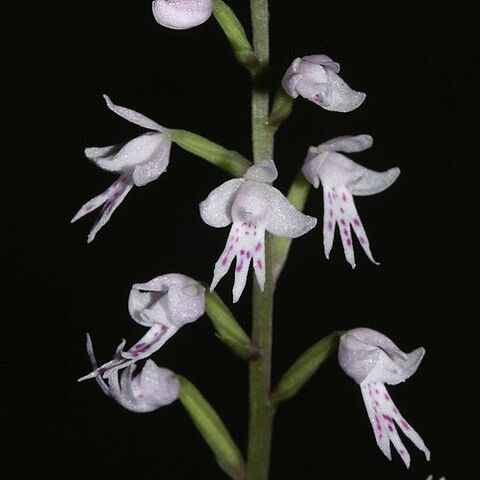Lithophytic, occasionally epiphytic or terrestrial. Leaves 6-20, linear to lanceolate or oblanceolate, concolourous to heavily spotted with brown or maroon, margins flat and entire to strongly undulate, up to 20 x 4 cm. Inflorescence up to 57 cm tall, 5-90 flowers; sheaths spotted or unspotted. Bracts lanceolate, acute to acuminate, spotted or unspotted, usually sheathing the ovary entirely, occasionally recurved at the apex, usually shorter than or equal to ovaries except for the lower bracts that are sometimes slightly longer than ovaries, 6.0-15.0 x 2.0-5.5 mm. Flowers white, pink or lilac, often spotted with a darker shade of pink or purple on all parts or labellum only; self-pollinating. Sepals ovate to narrowly ovate or elliptic, acute to obtuse, dorsal concave, laterals oblique to falcate, 3.5-7.0 x 1.5-4.0 mm, laterals slightly longer. Petals ovate, oblique, acute, 3.5-6.3 x 2.0-4.5 mm. Labellum unspurred, oblong to obovate in outline, 6.0-12.0 x 2.0-6.5 mm, highly variable; side lobes entire to incised or bifurcating; midlobe acute, longer than or subequal to side lobes. Column up to 2.5 mm long; stigmatic arms erect or suberect in mature flowers, straight or curving outward; auricles slender or widening slightly at the apex, up to 0.6 mm x 0.4 mm at the apex, adnate to the sides of the anther. Ovary 8.5-15.0 mm long.
Plants terrestrial, 100-400 mm tall, with elongate, fleshy roots; basal leaves in a rosette, 6-10, petiolate, lorate to narrowly oblanceolate, acute, spotted, margins strongly undulate, 25-150 (-190) x 5-16 mm; cauline leaves distant, narrowly lanceolate, acuminate. Inflorescences laxly to rarely densely 5-30 (-50)-flowered; bracts green, narrowly lanceolate, acute, 3-10 mm long. Flowers lilac, darker-spotted, tepals papillose. Sepals sub-equal, narrowly ovate, subacute, 3-8 x 2-5 mm; median shallowly concave; laterals oblique. Petals elliptic to narrowly elliptic, subacute, margins slightly crenate, 3-6 x 2-4 mm. Lip patent, narrowly obtriangular, trilobed, 6-15 mm long; midlobe usually narrower than side lobes; side lobes lorate to narrowly oblong, 2-4 mm long.
Terrestrial, lithophytic or epiphytic herb, 0.10-0.35 m high; many tuberous roots. Leaves 5-20, radical, in rosette at base of stem, oblong or narrowly lanceolate, 25-190 x 5-16 mm, dark purple-spotted, glabrous, margins undulate. Inflorescence slender, erect, lax, many-flowered raceme, subsecund, up to 300 mm long, often shorter; peduncle spotted; flowers whitish pink or lilac with purple markings; bracts small, spotted purple. Sepals ovate, subequal, spreading, unlobed, longer than petals; dorsal sepal 3-8 mm long. Petals slightly narrower than sepals, unlobed, porrect, enclosing column. Lip 6-15 mm long, obovate oblong, unequally 3-lobed, sometimes with additional teeth, spur absent. Flowering time Jan.-Mar.
Herb, up to 300 mm tall, with 5-20 spotted leaves arranged in a basal rosette. Lip of flowers without a spur. Flowers lilac or pink with a few darker spots.

